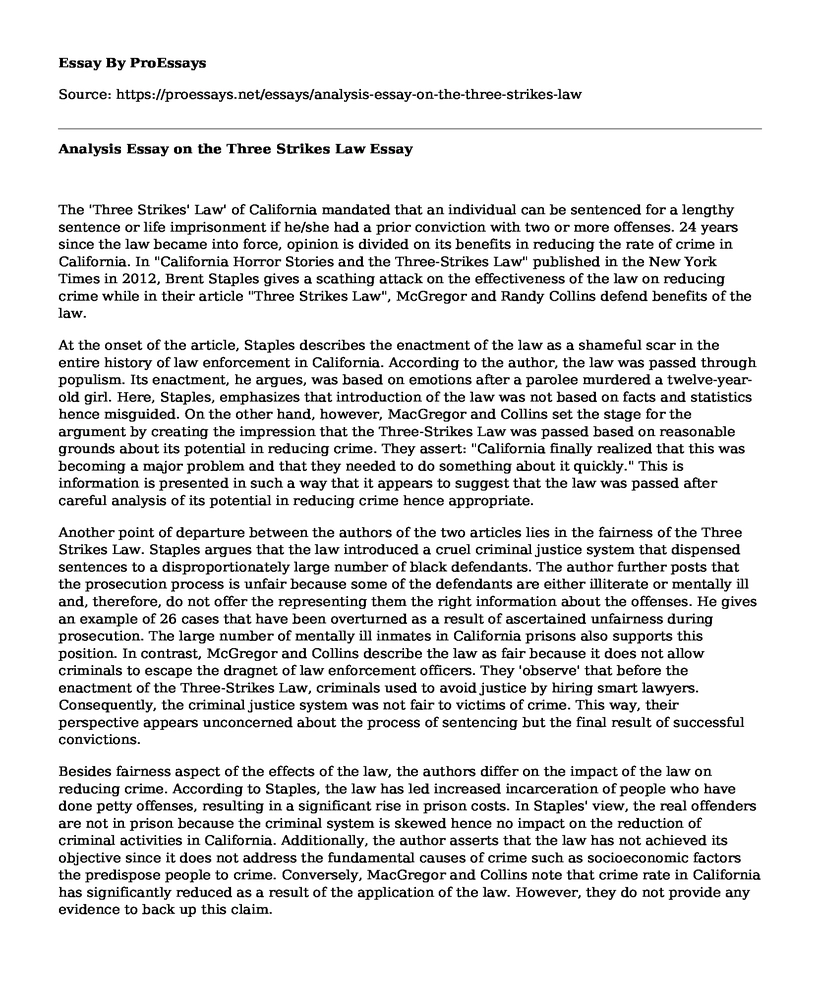The 'Three Strikes' Law' of California mandated that an individual can be sentenced for a lengthy sentence or life imprisonment if he/she had a prior conviction with two or more offenses. 24 years since the law became into force, opinion is divided on its benefits in reducing the rate of crime in California. In "California Horror Stories and the Three-Strikes Law" published in the New York Times in 2012, Brent Staples gives a scathing attack on the effectiveness of the law on reducing crime while in their article "Three Strikes Law", McGregor and Randy Collins defend benefits of the law.
At the onset of the article, Staples describes the enactment of the law as a shameful scar in the entire history of law enforcement in California. According to the author, the law was passed through populism. Its enactment, he argues, was based on emotions after a parolee murdered a twelve-year-old girl. Here, Staples, emphasizes that introduction of the law was not based on facts and statistics hence misguided. On the other hand, however, MacGregor and Collins set the stage for the argument by creating the impression that the Three-Strikes Law was passed based on reasonable grounds about its potential in reducing crime. They assert: "California finally realized that this was becoming a major problem and that they needed to do something about it quickly." This is information is presented in such a way that it appears to suggest that the law was passed after careful analysis of its potential in reducing crime hence appropriate.
Another point of departure between the authors of the two articles lies in the fairness of the Three Strikes Law. Staples argues that the law introduced a cruel criminal justice system that dispensed sentences to a disproportionately large number of black defendants. The author further posts that the prosecution process is unfair because some of the defendants are either illiterate or mentally ill and, therefore, do not offer the representing them the right information about the offenses. He gives an example of 26 cases that have been overturned as a result of ascertained unfairness during prosecution. The large number of mentally ill inmates in California prisons also supports this position. In contrast, McGregor and Collins describe the law as fair because it does not allow criminals to escape the dragnet of law enforcement officers. They 'observe' that before the enactment of the Three-Strikes Law, criminals used to avoid justice by hiring smart lawyers. Consequently, the criminal justice system was not fair to victims of crime. This way, their perspective appears unconcerned about the process of sentencing but the final result of successful convictions.
Besides fairness aspect of the effects of the law, the authors differ on the impact of the law on reducing crime. According to Staples, the law has led increased incarceration of people who have done petty offenses, resulting in a significant rise in prison costs. In Staples' view, the real offenders are not in prison because the criminal system is skewed hence no impact on the reduction of criminal activities in California. Additionally, the author asserts that the law has not achieved its objective since it does not address the fundamental causes of crime such as socioeconomic factors the predispose people to crime. Conversely, MacGregor and Collins note that crime rate in California has significantly reduced as a result of the application of the law. However, they do not provide any evidence to back up this claim.
Despite the contrasting positions, Staples and MacGregor and Collins agree that individuals who are involved in the crime have mental issues which predispose to the activities. However, Staples suggest that attention is supposed to be given to this group while MacGregor and Collins propagate the view that these persons do not deserve to be free. Moreover, the authors agree that crime is a significant socio problem in California hence there is a need to for a compressive solution.
Conclusion
Based on the analysis, the authors of the two articles differ on the fairness of the prosecution process under the Three Strikes Law and its effect on crime reduction. Staples holds the view that the law is not fair and does not contribute to the effective reduction of crime whereas MacGregor and Collins opine that the law is fair and has led to a decrease in crime rates in California. Given the amount of evidence provided by Staples, his article appears more convincing than that of MacGregor and Collins.
References
MacGregor, & Collins. (2018). Three Strikes Law in California. Retrieved from https://www.hg.org/legal-articles/three-strikes-law-in-california-23261
Staples, B. (2012). California horror stories and the 3-Strikes Law. The New York Times , The New York Times. Web 29th Sept 2018.
Cite this page
Analysis Essay on the Three Strikes Law. (2022, Aug 04). Retrieved from https://proessays.net/essays/analysis-essay-on-the-three-strikes-law
If you are the original author of this essay and no longer wish to have it published on the ProEssays website, please click below to request its removal:
- Judicial Systems of Brazil and Canada
- Summary of Legislation in Juvenile Crime Essay Example
- Criminal Justice Speech Example
- Teenager Convicted of Larceny: Judge Uses Preponderance of Evidence - Essay Sample
- Essay Example on DHS Established: Securing US Nation After 9/11 Attacks
- Jack & H.H Holmes: Synonymous Victorian Serial Killers - Essay Sample
- Free Report Sample on Criminal Intelligence Agency: Leveraging Math Models to Improve Decision-Making







